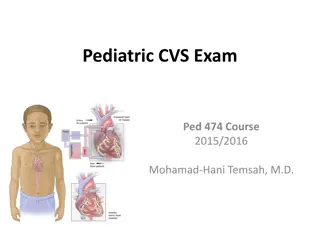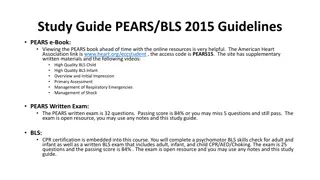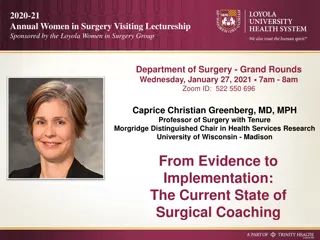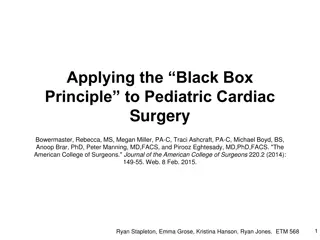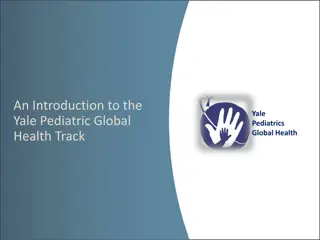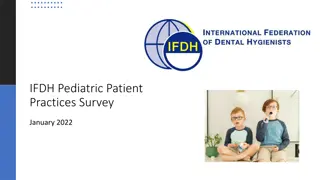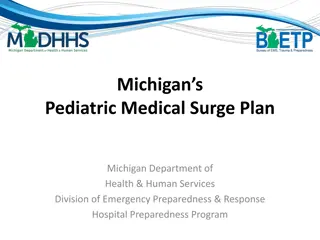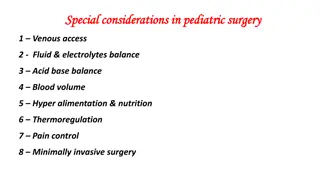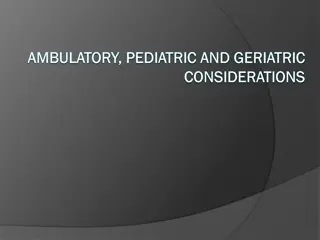Understanding Pediatric Surgery: Key Differences and Considerations
Pediatric surgery is a specialized field that differs significantly from general surgery due to unique anatomical and physiological aspects in children. This lecture covers key topics such as neonatal intestinal obstruction, atresia, and treatment approaches, highlighting the importance of tailored surgical care for pediatric patients.
Download Presentation

Please find below an Image/Link to download the presentation.
The content on the website is provided AS IS for your information and personal use only. It may not be sold, licensed, or shared on other websites without obtaining consent from the author. Download presentation by click this link. If you encounter any issues during the download, it is possible that the publisher has removed the file from their server.
E N D
Presentation Transcript
PEDIATRIC SURGERY-2018 Introduction No. :1 Attendance: Obligatory Type of lecture: theory Place : Hall no.4 college of medicine Mustansiriyah University . Date : Monday 5th of March 2018. Time : 8:00 9:00 AM. Students: 4th year / college of medicine / Mustansiriyah University By : Dr. Ali E. Joda M.B.Ch.B. - F.I.C.M.S. - pediatric surgeon. E. mail : ali.egab.joda@uomustansiriyah.edu.iq
Objectives:- What is the field of pediatric surgery & how it differs from general surgery? By the end of this lecture, you have to be able to recognize the main features of neonatal intestinal obstruction & how you can approach to infant with this problem. What is atresia & where it could be occur in gastrointestinal tract? How can you differentiate it from other causes of intestinal obstruction like malrotation of midgut & meconium ileus. What are the main lines of treatment?
Pediatric surgery is not just a general surgery performed in smaller people. Children need specialized surgeon to deal with their surgical problems because they differ markedly from that of adults in many aspects, including:- Unique physiologic demands that vary according to age and development, the neonate's physiologic development is closer to that of a fetus, while adolescents' physiology is similar to that of adults. For example in the Gastro-intestinal tract: Small size stomach (need small frequent feeds), Low level of digestive enzymes due to immature pancreas, underdeveloped gastroesophageal junction (GER is common until 6 months of age), Immature protective mucous layer (High risk of infection), Gastric pH is alkalotic at delivery.
Anatomical difference, Infants and small children have larger body surface area, their occipito-frontal circumference circumference, they have wide abdomen, broad costal margin and shallow pelvis, the edge of the liver comes below the costal margin, the bladder is largely intra-abdominal, the ribs are more horizontal and are flexible, the umbilicus is relatively low lying. The smaller size organs need gentle surgical skill. Implications: better to calculate drug dosage according to body surface area, Transverse supra-umbilical incisions give greater access than vertical midline ones for open surgery. Trauma (including surgical access) can easily damage the liver or bladder. The geometry of the ribs means that ventilation requires greater diaphragmatic movement, their flexibility means that rib fractures are rare and often a sign of abuse. exceeds the chest
Infants and children have pathology unique to their chronologic and developmental age, they may suffer from congenital abnormalities and tumors not seen in adults, and their management requires understanding the relevant embryology and pathogenesis.
Special considerations should be known about venous access, fluid & electrolyte, special drug dosage, thermo-regulation, blood volume & its products, pain control, hyper-alimentation & IV nutrition & minimally invasive surgery. Therefore, the pediatric surgeon is specially trained surgeon with extensive experience in treating children, infants, neonates & even fetus in utero with surgical problems. The pediatric surgical procedures need specialized centers with appropriate NICU (neonatal intensive care unit), trained staff, pediatric radiologist, anesthetist, pathologist & pediatrician etc.
Surgical Causes:- Intestinal atresia. Infantile hypertrophic Pyloric stenosis. Meconium disease. necrotizing enterocolitis. malrotation of midgut. Congenital peritoneal band. Hirschsprung s disease. Enteric duplication. Anorectal malformation. Mesenteric cyst. Complicated inguinal hernia. Trans mesenteric internal hernia
Main symptoms:- Vomiting: usually greenish due to bile stained. The higher obstruction the earlier vomiting. Abdominal distention: sever distention is seen in lower intestinal obstruction. While in upper intestinal obstruction the abdomen is flat or with minimal distension. Delayed or no passage of meconium: normally 50-250 g of meconium should be passed within the 1st 24-48 hr after birth.
Examination:- Lethargy, hypotonic: due to electrolyte disturbance, sepsis, peritonitis. Respiratory distress: due to abdominal distention, aspiration pneumonia. Obvious associated anomalies: like Down syndrome. Jaundice: due to prematurity, dehydration & associated biliary atresia. Visible peristalsis: especially in preterm with thin abdominal wall. On Superficial palpation: distended bowel loops, mass of meconium ileus, mass of necrotic bowel, enteric duplication, mesenteric cyst.
Tenderness: evident by crying, grimace, pulls up the leg. Infants never exhibit rigidity but edema, redness or echymotic appearance of abdominal wall indicates intestinal ischemia & necrosis. Inspection of anal orifice & rectal examination with little finger or probe to exclude imperforate anus, Hirschsprung's disease, meconium plug syndrome. Passing NG tube to exclude esophageal atresia.
Investigation:- Erect & supine abdominal X-ray (plain film): normally there is no air- fluid level in abdominal X-ray of neonate, the gas shadow is scattered throughout the abdomen, & it is difficult to distinguish between small & large bowel in neonate because the colonic haustration & mucosal folds of small bowel are not evident yet.
X-Ray findings of intestinal obstruction :- 1. Dilated bowel loops. 2. Air fluid levels. 3. Double bubble sign. 4. Gasless lower abdomen. 5. Other findings of complication or associated diseases: pneumoperitoneum, meconium pseudocyst, peritoneal calcification, soap bubble appearance, penumatosis intestinalis & others. Upper GI Contrast study (using barium or gastrografin) for suspicion of partial intestinal obstruction or suspicion of malrotation of midgut. Lower GI Contrast enema used for low intestinal obstruction, it differentiate between colonic atresia, ileal atresia, Hirschsprung's disease & Meconium ileus.




